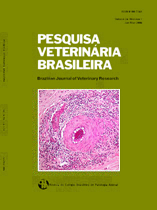 |
|
|
|
Year 2012 - Volume 32, Number 6
|

|
Morphological description of diaphragm of white-tufted-ear-marmoset (Callithrix jacchus), 32(6):553-558
|
ABSTRACT.- Lessa T.B., Constantino M.V.P., Silva L.C.S., Santos S.R.P., Assis Neto A.C., Miglino M.A, Bombonato P.P. & Ambrósio C.E. 2012. [Morphological description of diaphragm of white-tufted-ear-marmoset (Callithrix jacchus).] Descrição morfológica do diafragma do sagui-de-tufo-branco (Callithrix jacchus). Pesquisa Veterinária Brasileira 32(6):553-558. Departamento de Cirurgia, Programa de Pós-Graduação em Anatomia dos Animais Domésticos e Silvestres, Faculdade de Medicina Veterinária, Universidade de São Paulo, Av. Prof. Dr. Orlando Marques de Paiva 87, Cidade Universitária, São Paulo, SP 05508 270, Brazil. E-mail: thaisblessa@usp.br
The diaphragm muscle found only in mammals is the main muscle in the respiratory process, serving as the border between the thoracic and abdominal cavities. Its significance also is highlighted in research conducted with grafts using various types of biological membranes for the repair of diaphragmatic defects which may cause diaphragmatic hernias. In spite of many studies already conducted in non-human primates, especially in regard to the new world species Callithrix jacchus (white-tufted-ear-marmoset) from northeastern Brazil, research involving use of the diaphragm in such species is nonexistent. Thus, the objective was to characterize the morphology and biometry of the diaphragm in C. jacchus of both sexes, analyzing possible structural differences between males and females. To this end, we used four adult white-tufted-ear-marmosets from a commercial breeder, two males and two females that had died of natural causes. After fixed in 10% formaldehyde solution, the animals were dissected for photo documentation, the diaphragm was collected for biometrics (length and width) with a caliper, and for histological processing by hematoxylin-eosin and Trichrome Masson. The measurements showed that there were no significant differences between males and females. The topography and the presence of three openings (foramen vena cava, aortic et esophageal hiatus) in the extension of the diaphragm corroborate descriptions in classical literature for other mammals. Regarding the histological findings, it was concluded that the muscular fibers are arranged in an organized shape, with a large diameter and basal nuclei, and showed similar characteristics of skeletal muscle in males and females. |
| |
|
|
| |
|
 |